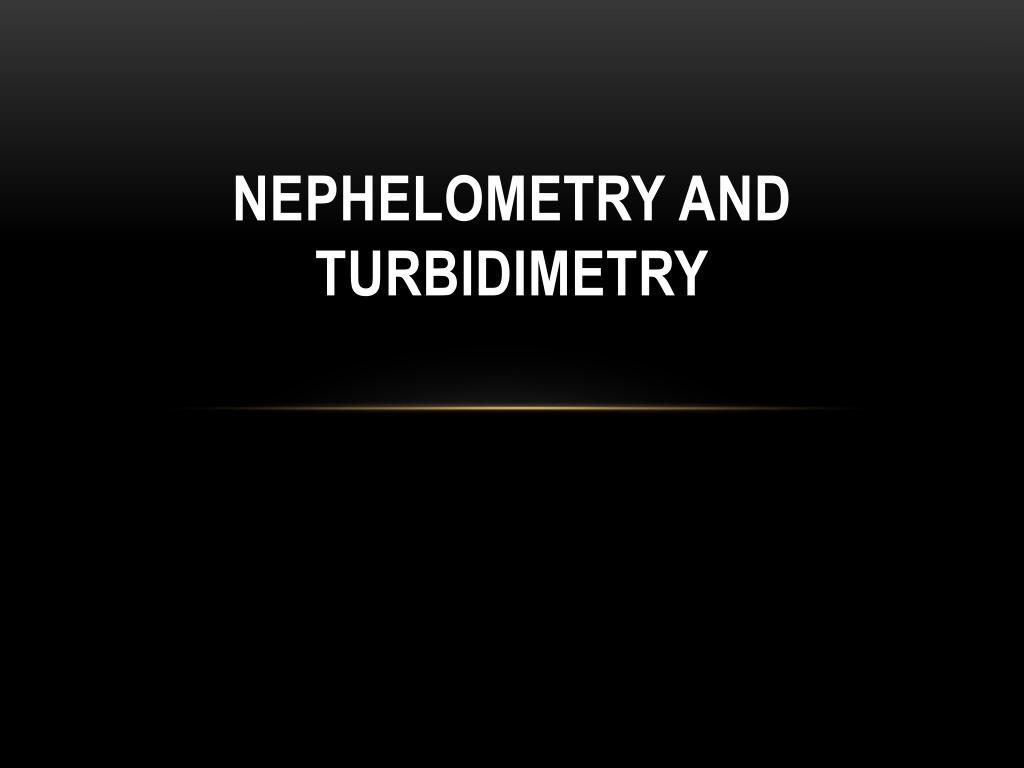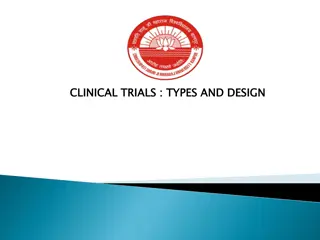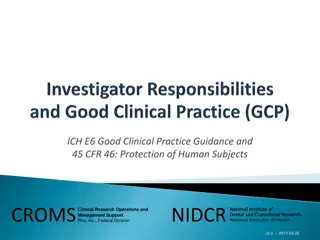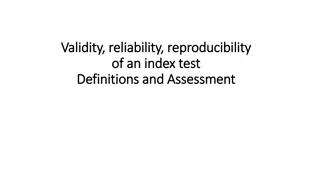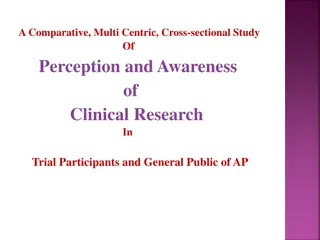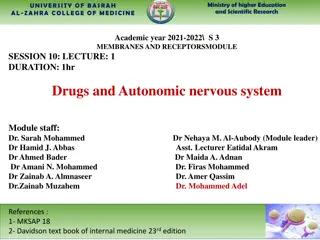Understanding Nephelometry and Turbidimetry in Clinical Applications
Nephelometry and turbidimetry are analytical techniques used in clinical settings to measure the amount of light scattered or absorbed by particles in suspension. Turbidimetry focuses on the amount of transmitted light, while nephelometry measures scattered light. Both methods are valuable in determining the concentrations of various substances in biological fluids, such as proteins, enzymes, and immunoglobulins. Nephelometry offers higher sensitivity due to the detection of scattered light and is widely utilized for antigen-antibody reactions and analyzing serum proteins. These techniques play crucial roles in medical diagnostics and research.
Download Presentation

Please find below an Image/Link to download the presentation.
The content on the website is provided AS IS for your information and personal use only. It may not be sold, licensed, or shared on other websites without obtaining consent from the author. Download presentation by click this link. If you encounter any issues during the download, it is possible that the publisher has removed the file from their server.
E N D
Presentation Transcript
NEPHELOMETRY AND TURBIDIMETRY
TURBIDIMETRY Turbidimetry is involved with measuring the amount of transmitted light (and calculating the absorbed light) by particles in suspension to determine the concentration of the substance in question. Amount of absorbed light, and therefore, concentration is dependent on ; 1) number of particles, and 2) size of particles. Measurements are made using light spectrophotometers
CLINICAL APPLICATIONS Determination of the concentration of total protein in biological fluids such as urine and CSF which contain small quantities of protein (mg/L quantities) using trichloroacetic acid Determination of amylase activity using starch as substrate. The decrease proportional to amylase activity. Determination of lipase activity using triglycerides as substrate. The decrease proportional to lipase activity. in turbidity is directly in turbidity is directly
NEPHELOMETRY. PRINCIPLE Nephelometry is concerned with measurement of scattered light from a cuvette containing suspended particles in a solution. The components of a nephelometer are the same as a light spectrophotometer except that the detector is placed at a specific angle from the incident light. The detector is a photomultiplier tube placed at a position to detect forward scattered light. Detectors may be placed at 90o, 70o or 37o depending on the angle at which most scattered light are found.
PRINCIPLE Since the amount of scattered light is far greater than the transmitted light in a turbid suspension, nephelometry offers higher sensitivity than turbidimetry. The amount of scattered light depends on the size and number of particles in suspension. For most clinical applications, the light source is a tungsten lamp giving light in the visible region For higher sensitivity and for applications that determine the size and number of particles in suspension, laser light nephelometers is used.
CLINICAL APPLICATIONS OF NEPHELOMETRY. Widely used to determine concentrations of unknowns where there is antigen-antibody reactions such as Determination of immunoglobulins (total, IgG, IgE, IgM, IgA) in serum and other biological fluids o Determination of the concentrations of individual serum proteins; hemoglobin, haptoglobin, transferring, c-reactive protein, a,1-antitrypsin, albumin (using antibodies specific for each protein) o Determination of the size and number of particles (laser- nephelometr}
CONSIDERATIONS IN TURBIDIMETRY AND NEPHELOMETRY The reaction in turbidimetry & nephelometry does not follow Beer's Law Therefore, standard curves must be plotted and the concentration of the unknown is determined from the standard curve. Because the absorbance is dependent on both number and size of particles, the standard solution which is used for the standard curve must have similar size in suspension as unknown. Because some precipitation and settlement of particles may occur with time, in order to obtain good accuracy it is important to ; a) mix the sample well prior to placing the cuvette in the instrument, and, b) keep the same time for measurement of every sample throughout the measurement.
Kinetic reactions (measurement of the progress of reaction with time) provides higher degree of accuracy, sensitivity, precision and less time than end-point reactions (measuring the reaction at the start and finish of the reaction) o Additionally in kinetic reactions there is no need for reagent blank since the previous reading is taken as the base-line for the next reading. o Kinetic reaction may be taken in 60, 90 or 120 seconds (taking readings at 10 seconds intervals), whereas endpoint reactions may take much longer time e.g. 15 -120 minutes.
SELECTION OF A WAVELENGTH If both solution and suspended particles are colorless, then use any wave length in the visible range If the solution is coloured but the particles are not coloured, then use a wave length that gives minimum absorption for the solution If the particles are coloured and the solution is colorless then use a wavelength that gives maximum absorption with the particles If both solution and particles are coloured then use two wavelengths; one that gives minimum absorbance for the solution and the other one maximum absorbance for the particles. Subtract the solution absorbance from the particles absorbance.
TURBIDIMETRY AND NEPHELOMETRY When particles are suspended in a solution in a cuvette, they make the solution unclear (turbid). Incident light entering the cuvette will be subjected to three reactions; 1- some of the light will be absorbed (blocked) by the particles 2- some will be transmitted through the cuvette 3- some will be scattered in various directions.
Turbid metric + nephlometeric analysis: When part of incident radiant energy is dissipated by absorption, reflection, and refraction, while the remainder is transmit light as a function of the concentration of the dispersed phase is the basis of turbid metric analysis
Nephlometer Turbidimeter Definition the measurement of the intensity of scattered light at right angles to the direction of the incident light as a function of the concentration of the dispersed phase ,It is most sensitive for very dilute suspensions (100 mg/L). Nephlometery machine Scattered light Light passing through a medium with dispersed particles, so the intensity of light transmitted is measured. Instrument used Type of light measured Arrangement of photometer measure the light scattered at right angle to the direction of the propagation of light from the source. It could be movable detectors which allow operator to vary the angle of detection Clinical uses Ag-Ab rxn, immunocomplex rxn,ppts, lipoprotein spectrophotometer Transmitted light made in the same direction as the propagation of the light from the source. Ag-Ab rxn, immunocomplex rxn,ppts, liver dis, protein in urine or CSF
INSTRUMENTATION: 1- light source: Tungsten its relatively low intensity makes it less useful for samples with low light scattering. Alternatives are: quartz halogen lamp, xenon lamp and laser which have higher intensities than tungsten lamp. 2-lens assembly: Light enter the sample holder through lens assembly.
3-there is provision for the insertion of filter between the sample and source of light(monochromator). 4- detector (photo cell): It is shielded to minimize interference from stray light. 5-Read out device: Light intensity is converted to an electrical signal by the detector .
EXAMPLE: The turbidity of a dilute barium sulphate suspension. The concentration of the reactants must be controlled by adding pure solid barium chloride of definite grain size. -NACL and HCL are added before the precipitation in order to inhibit the growth of microcrystal of barium sulphate -A glycerol ethanol solution helps to stabilise the turbidity. The reaction vessels is shaken gently in order to obtain a uniform particle size. Each vessel should be shaken at the same rate and the same number of times.
MEASURMENTS: 1-plug the instrument into ground outlet. 2- choose desirable scale from 0-10 starting with the highest conc. (for std 1=scale 10) 3- turn power switch on. 4-selecte desirable range by range selector at desirable position . 5- select filter required.
6- transfer your standards in the cleaned cell and place them in cell holder. 7- remove the standards. 8- fill the second cell with blank to set zero . 9- check the reading of the standards again. 10- measure your unkown. 11- draw calibration curve.
PRECAUTION: -Number and size of the particles should remain constant if repeated preparation are made -clean cell & filter - avoid air bubbles (high reading). -dilute sample if there is need. -prepare the blank ,standards, Sample at the same time.(to avoid ppt)
ADVANTAGES AND DISADVANTAGES : Advantages : rapidity of procedure and simplicity of the measurements. Disadvantages: lack of accuracy of the measurements.
